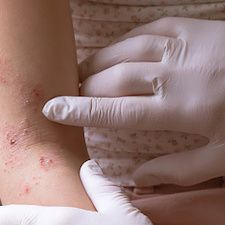Article
Study Highlights Major Causes, Management of Allergic Contact Dermatitis Cases
Author(s):
A recent cohort study of 20 emergency departments assessed allergic contact dermatitis cases.

A retrospective study examined the major causes and management strategies of allergic contact dermatitis (ACD) cases in 20 emergency departments (EDs) throughout the city of Melbourne, Australia.
Around 4900 different chemicals have been pointed out as the causes of ACD. Many of these cases are acute and end up leading to emergency treatments. This study’s investigators, led by Kate E. Dear and Claire Felmingham, decided to pursue the topic following several reported cases of ACD hospitalization due to the topical anti-inflammatory drug bufexamac.
“The now-banned topical anti-inflammatory bufexamac had caused several cases of severe ACD leading to hospitalization, and this had highlighted the dearth of information of the causes of severe ACD presenting to EDs,” Dear and colleagues wrote. “The aim of this study was to identify cases of ACD presenting to EDs in a large Australian city, with emphasis on the causes of severe and acute cases of ACD, and their management.”
Background
The investigators used a Melbourne-based, multi-site, retrospective cohort study with 334 participants recruited with unspecified contact dermatitis (CD). The participants’ ED information from July 2017 to June 2018 was generated through the Victorian Agency for Health Information.
The ACD patients recruited for the study had been admitted to one of any of the Victorian metropolitan public hospital EDs. The research team included cases specifically if ACD was either the presumed or possible diagnosis listed by the physician at the ED by the treatment’s end.
Additionally, the researchers collected data regarding patients’ presentation details, demographic information, and skin condition treatments. Statistical analyses were performed and significance established at P < 0.05.
The investigators reported that 334 patients across a total of 20 hospital sites in Melbourne had been given the description of “unspecified CD due to other agents” by an ED physician. They also found that 33 patients refused to take part in the study and the medical records of 8 patients were unavailable. Another 65 were determined not to have had ACD.
Findings
The investigators found that patients’ mean age was 37 years, with 108 patients being female (47.4%). Of the ACD patients assessed, about 11% of them had cases that were occupationally-related. The most prevalent ACD symptoms reported were:
- Pruritus in 56.1% of cases
- Swelling in 21.5% of cases
- Pains in 19.3% of cases
- Asymptomatic in 15.4% of cases
The investigators found that reported clinical signs included erythema for almost 83% of patients, followed by edema in almost a third of patients. The most commonly affected areas for ACD symptoms in patients were reported to be the face (32%), the arms (25.4%), the trunk (21.9%), and the legs (19.7%).
The research team found that the most common sources of ACD were personal care products, topical medications, and household or occupational chemicals, although the common causes were highly diverse and a third of causes were reported unknown.
The researchers noted that the dermatology departments were involved in only around a fifth of the ACD cases analyzed. In the cases in which there was dermatology input, steroid ointments rather than creams were substantially more likely to have been prescribed. They found that without dermatology input, patients were more likely to be prescribed steroid creams instead of ointments (P <0.001).
“Our study demonstrates the difficulty of non-dermatologists recognising likely irritants as allergens and therefore diagnosing ACD clinically,” they wrote. “Furthermore, the disparity in management of presumed or possible ACD between ED physicians and dermatologists is highlighted, particularly regarding the use of oral and topical corticosteroids.”
This study, “Presentations to emergency departments in Melbourne, Australia diagnosed as allergic contact dermatitis,” was published online at the National Library of Medicine.





